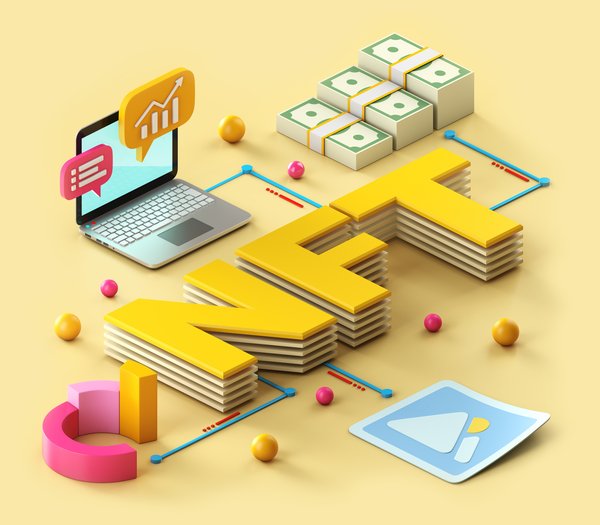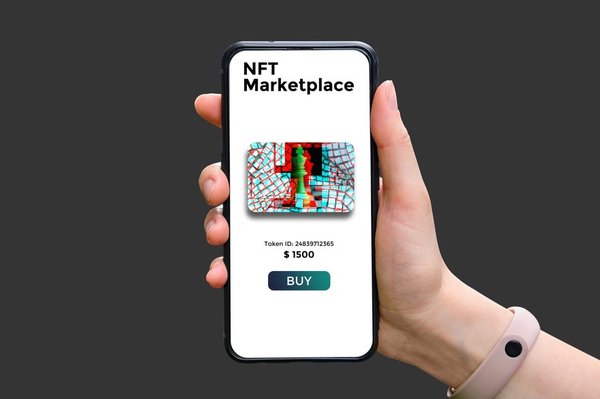NFTs have exploded in popularity during the pandemic, leading many investors to wonder how to buy them. Artists, collectors, and speculators alike have flocked to the movement as cryptocurrencies and other digital assets have skyrocketed -- and also plummeted -- in price. Buyers have paid millions of dollars for digital art pieces, such as the pixelated CryptoPunks character portraits.
The jury's still out on whether this is an unsustainable bubble ready to pop, or if this is the birth of a new long-term investment asset class. But NFTs themselves hold promise for artists and have applications in the business world.
Not sure what NFTs are and how to get started investing in them -- or whether you should in the first place? Here's what you need to know.
How to buy, create and sell non-fungible tokens
NFT stands for "non-fungible token." NFTs are used to indicate ownership or another usage right of a unique asset -- usually a digital asset such as a piece of art, musical composition, or an item within a video game.
These tokens are built and managed on a blockchain, the same digital ledger technology system utilized by Bitcoin (CRYPTO:BTC) and other types of cryptocurrencies. NFTs are usually based on the Ethereum (CRYPTO:ETH) network, but there are other blockchains some NFTs use as well, such as Solana (CRYPTO:SOL) and Polkadot (CRYPTO:DOT).
Think of these digital tokens as a type of virtual certificate similar to a physical certificate or title that you might present to prove you own a physical asset such as real estate. They're a digital proof of ownership originally designed for digital assets and art. However, NFTs can also be used to guarantee ownership of unique physical assets for everything from property to collectibles to physical works of art. For our purposes, we'll refer to NFTs primarily as representing virtual assets unless otherwise specified.
A word of caution, though: Not all NFT projects are created equal. Some projects sell NFTs without the actual creative or ownership rights of the digital asset itself. As with all purchases, thoroughly research a potential purchase so you know what you are buying. NFT marketplaces offer terms and conditions including a license that applies to NFTs purchased on their site. These terms vary from marketplace to marketplace, and some NFTs have specific, customized license rights. The NFT license agreement is the most important thing that determines an NFT buyer's rights, so you should read it before buying!
If an NFT has an associated image or other digital form, that associated data might be stored in a separate blockchain network, making it more complicated to fully understand the concept of “ownership.” Sometimes, NFT data is separately stored in the InterPlanetary File System. If so, that detail should be included in the NFT description.
As with any creative industry, there have been some problems with “counterfeit” NFTs. It is important to research the reputation of the original NFT seller.
Even if the seller is legitimate, the investment itself may not pan out the way you expect. And NFT investments have proven quite volatile. For example, Twitter (NYSE:TWTR) CEO Jack Dorsey's first tweet was sold as an NFT for $22.9 million in March 2021. Barely one year later, in April 2022, the NFT went back on the market, but couldn’t command bids above $280.
How to buy NFTs
NFTs are bought and sold via a purpose-built NFT marketplace, kind of like Amazon (NASDAQ:AMZN) or Etsy (NASDAQ:ETSY), only for digital assets. These marketplaces can be used to buy an NFT at a fixed price or function as a virtual auction, much like the exchange system for buying and selling cryptocurrencies and stocks. Prices on NFTs listed for sale via auction are therefore volatile, changing in value depending on demand. The higher the demand, the higher the price.
A key difference between NFTs and stocks and cryptos is that stocks and cryptos are fungible -- meaning each unit is just like the other. One share of Amazon is the same as another share of Amazon, and one Bitcoin token is equal to another. NFTs are non-fungible, meaning the token you buy represents a unique item not directly replaceable by anything else.
To bid on these digital asset tokens, you'll need to open and fund a crypto wallet on an NFT marketplace. A crypto wallet, like a digital wallet on an e-commerce platform, stores cryptocurrencies needed to purchase an NFT. A wallet needs to be funded with the crypto needed to buy a targeted NFT. For example, an NFT built on the Ethereum blockchain technology might require its purchase in Ether tokens.
There are a variety of marketplaces that support NFT purchases. Top NFT marketplaces include OpenSea, Rarible, SuperRare, and Foundation. There are other niche marketplaces that specialize in particular assets. For example, NBA Top Shot is owned by the National Basketball Association and sells clips of player performances as NFTs. Regardless of the marketplace, a crypto wallet will need to be opened and funded before bidding on and buying an NFT.
An NFT can be any digital asset like a piece of art, music, video, or object within a video game.
How to sell NFTs
Once you own an NFT, the digital asset is (usually) yours to do with as you please. You can keep it as a collectible, display it for others to see, or use it as part of a larger digital project. You can also list it for sale. Marketplaces charge a fee for NFT sales. These fees can fluctuate based on the blockchain network the NFT uses since the blockchain computing needed to verify the NFT consumes energy, known as a "gas fee."
To sell a digital asset you own, the piece will need to be uploaded to your marketplace of choice, provided that marketplace supports the blockchain the NFT was built on. From there, you can choose to list it for sale at a set price or opt for an auction-style sale in which buyers place bids.
Once uploaded, the marketplace will verify the asset. After it's sold, the marketplace will handle the transfer of the NFT from the seller to the buyer and will also transfer crypto funds to your wallet less the listing fee and other related blockchain computing expenses.
How to create NFTs
Part of the allure of NFTs comes from creators -- artists, musicians, filmmakers, writers, and the like -- who can guarantee the authenticity of their work and monetize it as NFTs. Anyone can turn a digital asset into an NFT (or "mint" it) and sell it on a marketplace.
Each platform handles things a little differently, but the basic minting process is as follows:
- Have a crypto wallet opened and funded (like with Ether in order to cover the computing fees involved with creating the NFT).
- Click the "create" button within the marketplace and upload your work.
- List the NFT for sale either for a fixed price or for sale via auction.
Pros and cons of NFTs
The value of some NFTs has skyrocketed in the last couple years and attracted a lot of attention from the investment community. There certainly are some merits to consider when buying and using NFTs:
- Certain physical collectibles (such as art) have a long track record of appreciating in value, and digital art could exhibit the same price appreciation.
- Buying and selling digital assets as NFTs yields access to potentially far more buyers and sellers than in the past.
- "Smart contracts," meaning a set of coded commands built into the blockchain, can ensure that artists and creators get paid based on the use and resale of their work in the future.
- NFT platforms can control which NFTs are shown and not-shown in their marketplace, allowing them to “blacklist” some problematic NFTs or creators. Although content moderation is not philosophically aligned with the intent of immutable blockchains, most NFT marketplace users appreciate the removal of known unauthentic or otherwise illegitimate NFTs.
But there are also some reasons not to invest in and use NFTs:
- Since most NFTs represent static assets that don't generate any income on their own, they are primarily valued by subjective metrics such as buyer demand. Consequently, sky-high prices may not last forever, and NFTs could lose considerable value.
- Creating and selling NFTs isn't free, and the fees can add up to more than an NFT is valued by other users on a marketplace.
- NFTs and the blockchain technology they're built on have an environmental impact since they use up a significant amount of energy to create and verify transactions.
- Some NFT projects may not guarantee the rights to the digital asset itself, so make sure to do some homework to determine where the digital asset is located (at a web address, in storage in a central cloud location, etc.) and whether you can control moving the asset to a different location.
Are NFTs the right investment for you?
The NFT movement is new and is an early demonstration of the potential cryptos have to make the digital economy work for more people. Creating and selling digital assets might make a lot of sense for creators. But when it comes to buying NFTs for their value as a collectible, they are a speculative investment. Value is uncertain and will fluctuate based on demand for the work itself.
There's no set rule for figuring out which collectible will increase in value and which one won't. But identifying a new NFT trend early can pay off big later on. Some digital works of art that originally sold for petty values have gone on to sell for many thousands of dollars.
If you have an eye for art, music, etc., and you enjoy collecting, dabbling in NFT investing might make sense for you. Some things to look for when buying include the creator of the asset, how unique the piece is, the history of the asset's ownership, and whether, once owned, an asset could be used to generate income (for example, payment to view a piece or relicensing fees).
As to the argument that NFTs are a "bubble" waiting to pop, bubbles are usually only revealed in hindsight. But bear in mind that doesn't change the fact that digital assets could indeed cool off at some point in the future. In fact, crypto and NFT projects began to witness widespread pullback in early 2022 along with the stock market. Weigh the risks, and diversify your investments -- perhaps by mixing in cryptos as well as stocks of businesses developing blockchain technology to your NFT portfolio.
NFTs are in the early days of development. It's a promising new front in the world of technology, but risks abound when investing in any movement's nascent stage. Tread lightly as you learn more about NFTs, and remember to stay diversified with your investments to limit the risk of any single asset derailing your wealth-building progress.


























